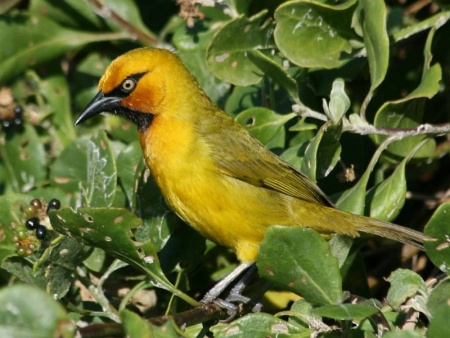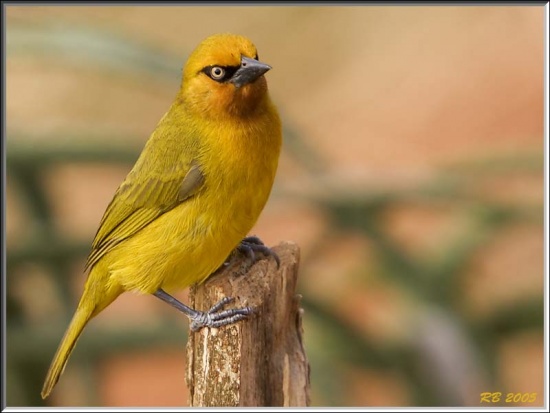
Ploceus ocularis
SUBFAMILY
Ploceinae
TAXONOMY
Ploceus ocularis A. Smith, 1828, Eastern Cape = Grahamstown,
South Africa.
OTHER COMMON NAMES
French: Tisserin а lunettes; German: Brillenweber; Spanish:
Tejedor Moteado.
PHYSICAL CHARACTERISTICS
5.9–6.3 in (15–16 cm); female 0.7–1.0 oz (21–30 g), male
0.8–1.1 oz (22–32 g). Greenish yellow weaver with slender,
dark bill and dark “spectacle” line through the eye. Eyes pale
cream. Male has dark bib on the throat, lacking in female. Juvenile
lacks spectacle line or bib, eye brown, bill pale brown.
DISTRIBUTION
Cameroon east to Sudan, Ethiopia, south to northern Namibia,
northern Botswana, and eastern South Africa.
HABITAT
Open woodland, forest edge, thickets, and gardens.
BEHAVIOR
Singly or in pairs throughout the year, family groups after
breeding. May join mixed-species flocks of insectivorous birds.
Territorial, calling regularly, a descending “tee-tee-tee-tee.”
FEEDING ECOLOGY AND DIET
Mainly insectivorous, gleaning leaves and branches and probing
bark. Also takes berries, small geckos, nectar, and bread
and chicken feed in gardens.
REPRODUCTIVE BIOLOGY
Nests are finely woven, suspended singly from tip of vegetation,
with entrance tunnel 4 in (10 cm) long. Lays one to four
eggs, usually two to three, in spring to summer in different regions.
Incubation 13–14 days, fledging 15–19 days. Both sexes
incubate and feed young. Occasionally parasitized by Diederik
cuckoo (Chrysococcyx caprius).
CONSERVATION STATUS
Not threatened. Widespread over large area, occurs in manmodified
habitats such as suburban gardens.
SIGNIFICANCE TO HUMANS
None known.
Photo Gallery of - Spectacled weaver




 Animalia Life
Animalia Life